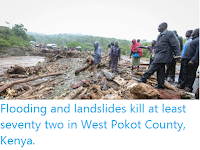About twenty houses have been destroyed and about fifty people made homeless after a landslide hit the village of Gachuha in Nyandarua County, Kenya. Nobody was injured in the incident, but several people report having lost livestock. The incident happened in the afternoon of Friday 27 December 2019, following weeks of heavy rain in the area. Landslides are a common problem after severe weather events, as excess
pore water pressure can overcome cohesion in soil and sediments,
allowing them to flow like liquids. Approximately 90% of all landslides
are caused by heavy rainfall.
Cleanup operations following a landslide in Gachuha Village, Kenya, on Friday 27 December 2019. The Standard.
The incident occurred after about a month of heavy rains, in one of the
area's two annual rainy seasons. This two rainy seasons per year pattern
is typical in equatorial
countries, with rainy seasons around the equinoxes and dry seasons
around the solstices. Upland areas of Kenya have always been prone to
landslides, but the problem has become worse in recent years as a rising
population has led to more agriculture on hill-slopes, in many areas
replacing open woodland where tree roots served to stabilise slopes, and
also to more people living in harms ways.
The rains this year are thought to have been made worse by the
development of a meteorological phenomenon called a Negative Indian
Ocean Dipole. Indian Ocean Dipole Phases are similar to the El Niño/La Niña
climatic oscillation that affect the Pacific Ocean. Under normal
circumstances equatorial waters off the east coast of Africa and west
coast of Indonesia are roughly similar in temperature, however during a
Negative Indian Ocean Dipole Phase the waters off the coast of Indonesia
become significantly warmer. As the prevailing currents in the area
flow west to east, this warm water is then pushed onto the shallower
continental shelf of north Australia, where it warms the air over the
sea more rapidly, leading to increased evaporation (which fuels rain)
and a drop in air pressure over the east Indian Ocean and west Pacific.
This in turn drives air currents over the Indian Ocean to flow more
strongly west to east, leading to higher rates of cooling off the coast
of Africa (where more water is drawn up from the cool sea depths) and
more warming off the coast of Indonesia, fuelling a feedback cycle that
tends to remain through the winter season in any year when it forms.
This leads to a particularly wet winter across much of Australia, as
well as a potentially damaging heatwave in the north, while much of East
Africa is at risk of drought (during a Positive Indian Ocean Dipole
Phase the reverse happens, with drought in Australia and flooding in
East Africa).
Areas of warming and cooling and air flow during a Negative Indian Ocean Dipole Phase. Australian Bureau of Meteorology.
See also...
Follow Sciency Thoughts on
Facebook.








